The New York City Ballet puts on a Gala to ignite its Fall Season.
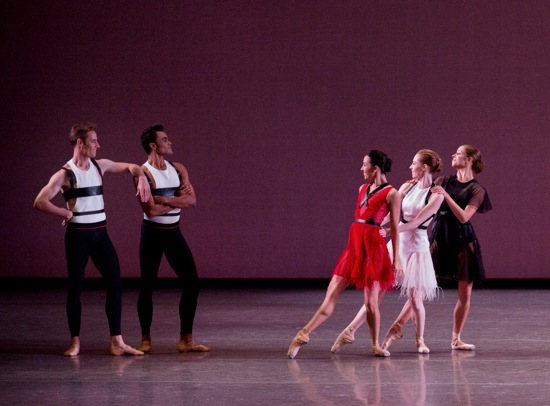
(L to R) New York City Ballet dancers Andrew Veyette, Taylor Stanley, Brittany Pollack, Ashly Isaacs, and Kristen Segin in Justin Peck’s Capricious Maneuvers. Photo: Paul Kolnik
Gala performances are strange animals—the bigger the dance company, the more lavish they have to be. Money is spent so that more money may accrue. At the New York City Ballet’s Fall Gala in its Lincoln Center home, designer Bronson van Wyck has hung huge blue-and-white and red-and-white-striped hot air balloons over the promenade—each bearing a basket of flowers. Hopes flying high. A thank you and a hint to the patrons who will dine there after the performance.
The theme of this gala is fashion. Important guests walk a red carpet to enter the theater. Some of them wear impressive gowns and partake with care of the hors d’oeuvres being passed (catering by Bite)—the most startling of which has three ingredients (one is cognac) packed into a morsel smaller than a ping-pong ball. Each of the evening’s three premieres features costumes by interesting fashion designers: Prabal Gurung for Justin Peck’s Capricious Maneuvers, Iris Van Herpen for Benjamin Millepied’s Neverwhere, and Olivier Theyskens for Angelin Preljocaj’s Spectral Evidence.
Each ballet is preceded by a short film featuring the designers at work. These films are enlightening and not without bits of sly humor (some of it unintentional), as the designers and choreographers discuss what they need, and the company’s costume supervisor, Marc Happel, tries to make it happen. The dancers being fitted cope with such items as boots made of a sliced, black, metal-like substance that pull on over their pointe shoes (Van Herpen), and odd-shaped slabs of a red plastic substance that are attached to the white garments worn by the women in Spectral Evidence. (Theyskens).
No thank-you speeches tonight, and the program runs smoothly without a break. NYCB’s management knows that if you give this stellar crowd an intermission, you’ll have trouble herding them back into the theater (too much to chat about and stare at). Appropriately enough, the overture by one of Artistic Director Peter Martins’s favorite composers, John Adams, is titled Short Ride in a Fast Machine.
As an extra perk for gala-goers, Capricious Maneuvers and Neverwhere are announced as one-time-only events. Which is too bad, because both are smartly made and interesting to watch—certainly not flashy throw-aways. I’m embarrassed to say that I have missed seeing any of Peck’s previous ballets for the company, only heard about this young NYCB soloist’s considerable talent. His new ballet is fresh and clever. Pianist Alan Moverman and cellist Fred Zlotkin play Lukas Foss’s Capriccio on one side of the stage, and various of the five dancers hang out by the piano when they take a break from dancing. Gurung has costumed the three women (Ashly Isaacs, Brittany Pollack, and Kristen Segin) in short red, black, or white dresses made of a light, ragged-edged fabric that whips out nicely when the dancers spin. Andrew Veyette and Taylor Stanley wear black tights and have black harnesses strapped over their white wife beaters. Capricious indeed.
Peck pits frisky classical steps with bits of irregular behavior. The women briefly support the men when the latter wish to turn, and Veyette, who performs splendidly in a solo, ends up supine on the floor. The situation is the opposite of that made famous in Jerome Robbins’s Fancy Free. In that 1943 hit, three sailors vie for two women. Peck’s three women display no particular rivalry. In this playful piece, they’re pals. So what if Pollack duets with Stanley? The evening is young.
Millepied’s Neverwhere is longer and darker. A low, light-streaked, pyramid-shaped expanse of pale material contrasts with the black backdrop against (or behind?) which it’s set. In the silence before pianist Nancy McDill and violist Maureen Gallagher begin to play Nico Muhly’s Drones and Viola from the pit, you can hear Van Herpen’s costumes. Not only do they sparkle in Mark Stanley’s lighting, they rattle. Clad in what looks like gleaming jet-black armor or beetles’ carapaces, the five dancers (Tyler Angle, Emilie Gerrity, Joseph Gordon, Craig Hall, Sterling Hyltin, and Lauren Lovette) look like members of a chic planetary tribe that might baffle any Star Ship Enterprise crew. How Happel and his costume-shop assistants manage to make Van Herpen’s radical designs (which are constructed of material not usually worn by human beings) fit and not encumber the gallant dancers is something of a miracle. As they move about in Stanley’s lighting, flashes of white and blue appear and vanish on the shining scales that encase them.
These people are not robots though. Not far into the piece, they’re all on the floor, and the lights go out. When we see them again, they’re huddled together at the back. As the viola begins to call out slowly, one dancer becomes a body for the whole group to support. But Millepied isn’t telling any stories, nor does he seem to embrace the fascinating music’s structural principle. In each movement one or the other instrument establishes a drone and maintains it throughout, with possible changes of intensity, while the other instrument weaves its own song. “The idea,” Muhly has written, “is something not unlike singing along with one’s vacuum cleaner, or with the subtle but constant humming found in most dwelling-places.”
Millepied is an adroit choreographer, able to create intrepid, variegated patterns within a classical framework. The three women travel together through a fast-footed trio, circling their arms, and finishing with a skein of piqué turns. The three men work in close proximity—non-competitively muscling around. There’s a duet for Lovett and Hall, one for Gerrity and Gordon, and a longer one for Sterling Hyltin and Tyler Angle—two marvelously fluent and sensual dancers. Neverwhere, as its title suggests, is something of a mystery. You could think of it like this: a band of brave dancers marooned on a distant planet get together and remember Balanchine.
Spectral Evidence is not Preljocaj’s first ballet for NYCB. In 1997, he choreographed La Stravaganza for the company’s Diamond Project (Millepied danced in it, as he did in the 2009 revival). In the earlier ballet, programmed for the company’s 2014 spring season, inhabitants of two worlds gradually mix; some are contemporary people, while others appear to have emerged from a painting by Vermeer. A weird but fascinating piece. Spectral Evidence, instead, mingles “real” people and the spirits they dream about, with confusing, if highly theatrical results.
The title refers to evidence accepted at the Salem witch trials in 17th-century New England, although even a strict Puritan like Cotton Mather doubted that it wasn’t always reliable. If a person, the reasoning went, dreams of a familiar member of the community exhibiting possibly diabolical behavior, then the person dreamed of could be a witch. The seizures and rantings and pointing fingers began in Salem as inexplicable hysteria among girl children and spread through other Massachusetts communities, with accusations brought against apparently devout and law-abiding citizens, along with healers and others suspected of conspiring with the Devil. No one knew what to believe; the innocent thought they might be guilty; a mother was executed as the result of testimony drawn from her four-year-old daughter. At Salem, many were tried, 19 were hanged, and one who would not confess was pressed to death with stones.
The calamitous story was told in a play, Arthur Miller’s The Crucible, and in a movie based on it. History is not always suitable dance material, so Preljocaj re-wrote it in order to create a sexy and movement-enabling narrative. None of the girls who started the madness in Salem were accused of anything. But Tiler Peck, Megan Fairchild, Georgina Pazcoguin, and Gretchen Smith, the four daring female dancers in Spectral Evidence are dreamed-of young temptresses who whisper what are surely tales of forbidden pleasure into the ears of stiffly upright young men (Robert Fairchild, Adrian Danchig-Waring, Chase Finlay, and Amar Ramasar—all terrific), who look far more satanic than the women in their semi-transparent, loose-fitting white dresses with those ugly red patches sewn to them.
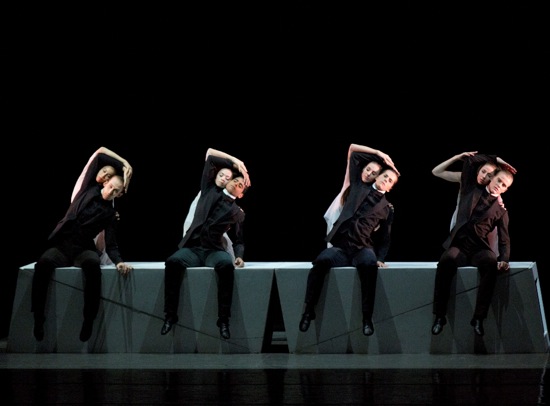
(L to R): Adrian Danchig-Waring, Amar Ramasar and Megan Fairchild, Robert Fairchild and Tiler Peck, Chase Finlay and Gretchen Smith in Spectral Evidence. Photo: Paul Kolnik
Ironically, the ballet (which uses few classical steps and no pointe shoes) is set to some unusual recorded compositions by John Cage for voice and electronic effects. Some of the pieces sound quite “holy,” as if a minister were chanting in the wilderness; at least one is charged with harsh, heavy breathing, gibberish, and eruptions from what could well be hell. It’s ironic that Cage used text from James Joyce’s Finnegan’s Wake and an E.E. Cummings poem—hardly witchy material.
As the piece begins, the four men are sitting immobile on a long, white box, about the size of a Last Supper table (the brilliant, moveable set was conceived by the choreographer and created by the production staff). They wear contemporary black suits and shirts with a hint of what might be a white clerical collar. A faint white haze seems to hover around their edges—Preljocaj’s first theatrical coup. The “haze” is the women, each of which is concealed behind one of the men. They lean their heads on the shoulders of their “victims” and touch them in mild— but no doubt forbidden—ways. When the men descend to dance in a severe and assertive manner, the women lie on the platform like discarded dolls.
Second theatrical coup. There’s a crash in the music. Stanley seconds it with a burst of harsh light, and the four men yank the platform into two parts, which now form a V in the middle. Up and down those two white slopes, the women crawl and slide; they even leap between surfaces. Cage’s music is full of thuddings, ringing tones, hoarse breathing, and other hellish sounds. The women lash and bend; the men (oh yes!) dance with them. The women (specters, remember) rub their hands down the men’s bodies and then disappear behind the set, while, in red light, the men dance and beat rhythmically on the white surface.
Fairchild gives a virtuosic performance as a man possessed—his body twisting, his gestures crabbed, his steps staggering. He lip-synchs the distorted spoken fragments in Cage’s score. (I believe the piece that accompanies his solo is No. 52 “Aria No. 2” (Relevant) from Song Books, with its unexpected, “Qu’il fait bon vivre,” although Fairchild is doing anything but living well.)
Third theatrical coup (a sadistic vision). The four pieces of the set are now set on end, and flames are projected into their open sides, where the women writhe in a dream-like way. (The condemned at Salem were hanged, but that’s not as dramatic, I guess, or as feasible on stage as having them burned alive.) Then these same white structures are turned to entomb the victims. In the end: a new arrangement of the set, a bright, white light, and a high voice calling out. The four women climb onto the platforms and jump off into sudden blackness.
So somehow, the tragic and insane events that occurred at Salem in 1692 and 1693 have become a lurid danceable tale of rigidly virtuous men so tempted by the women of whom they dream that they (virtually, if not actually) incinerate those visions. The last image we see is of the spectral women vanishing into thin air. Whether the men are now safe from damnation, we don’t know. Nor do we really care.
For purgation, the audience at the Gala is treated to the 4th Movement and the Finale from George Balanchine’s Western Symphony. Let’s hear it for the cowboys and dance-hall girls that this Russian-born genius loved! Let’s cheer for Maria Kowroski in her big hat, strutting and flirting and hopping along on one toe to show her prowess. Let’s be delighted by the sailing jumps that her partner, Zachary Catanzaro, tosses off, and the way he fans his hat to keep things cool. Ashley Laracey, Alan Peiffer, Sean Suozzi, Pollack, Lovette, and Stanley— the dancers we would have seen had the whole 1954 ballet been performed—have hung around gamely in order to appear in the go-for-broke wrap-up. As have conductor Andrews Sill, the NYCB Orchestra, and many dancers of the corps de ballet.
Kowroski is an established and beloved principal dancer; Catanzaro is a member of the corps de ballet. That democracy of talent was a happy part of the evening and a testament to the prowess and versatility of the company’s performers. In all three new ballets, principals, soloists, and corps dancers performed together as equals. That, as much as anything, made the occasion a gala one.

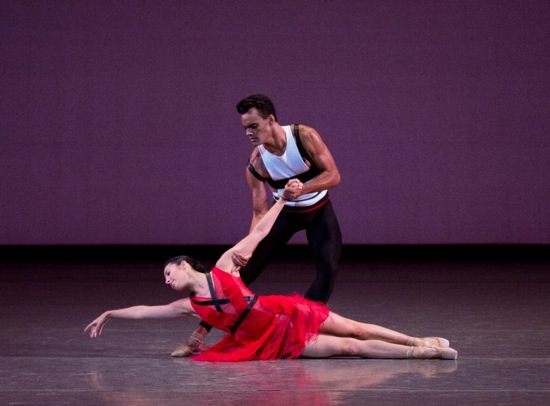
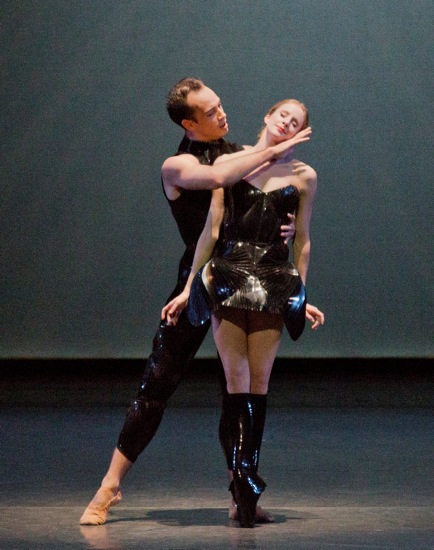
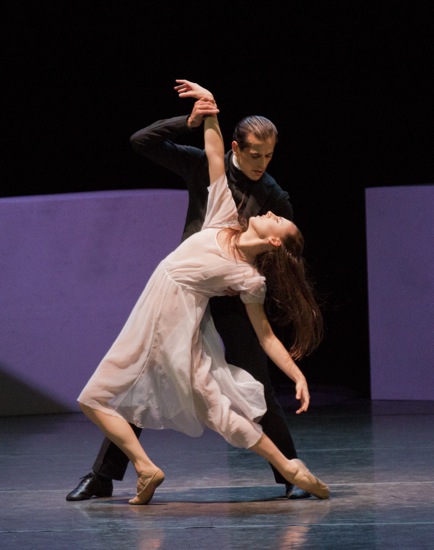
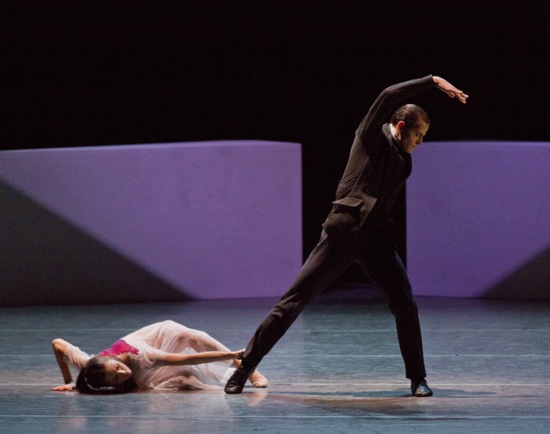
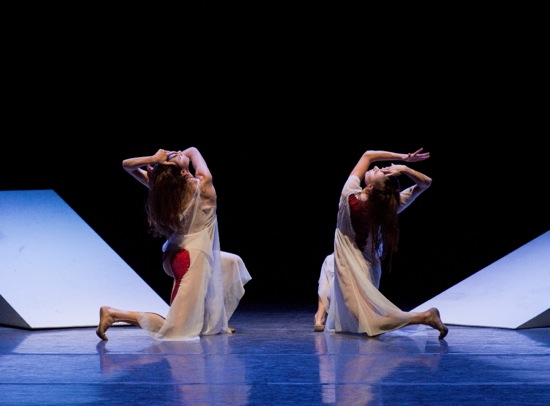
It’s delightful to have this fine, careful account of the NYCB Gala, especially if Peck’s ballet is truly a one-off (I can’t imagine that, though, since his other works have proved very popular). This is clearly a small piece for Peck, but it seems to smack of the freshness and ingenuity that make his other pieces worth watching. Year of the Rabbit, especially, is one of the best new ballets in years. Peck really hears music, knows what looks good on dancers, and has a knack for satisfying structure.
Your comment about Millepied’s doing nothing with Muhly’s drones goes right to the heart of his shortcomings as a choreographer. His lack of musicality often makes his movement look as though imposed on the score, rather than expressing it or arriving at a striking simultaneity with it, and since he doesn’t perceive the music’s structure, his ballets tend to lack choreographic structure, becoming a collection of striking and not-so-striking individual moments that don’t build.
And thanks for having watched the Prelocaj so we don’t have to!
As always, a richly evocative precis of the evening. Two typos, though: the long pas de deux in “Neverwhere” was for Sterling Hyltin and Tyler Angle (not Peck; how many Pecks? how many Angles?); the conductor of “Western Symphony” was Andrews (not Andrew) Sill.
I’m grateful for Barbara’s comment (and for her eagle eyes). The corrections have been made (plus one she missed!).
How many Pecks? One more than a bushel.
(sorry, couldn’t resist)
I caught up with Spectral Evidence last night. A first and last viewing, I hope. Your detailed description of this odd work is wonderful, although I note that you never say that you really liked it .Despite the original movement vocabulary and the effective set and lighting I found the work pretentious and unpleasant (much like the choreographer’s previous La Stravaganza.). The unfortunate red patches on two of the girl’s tushes brought to mind male mandrill’s red bottoms! I have only admiration though, for the brilliant performances by all of these wonderful dancers.
Like my pal Barbara P., I can’t help pointing out slight errors in the details of your review — it’s the girls who start beating on the sets as the men dance, then the men join them in the thumping. But no matter.
I hope that the Peck and Millepied ballets will eventually enter the NYCB repertory, and that Spectral Evidence will soon fade away.